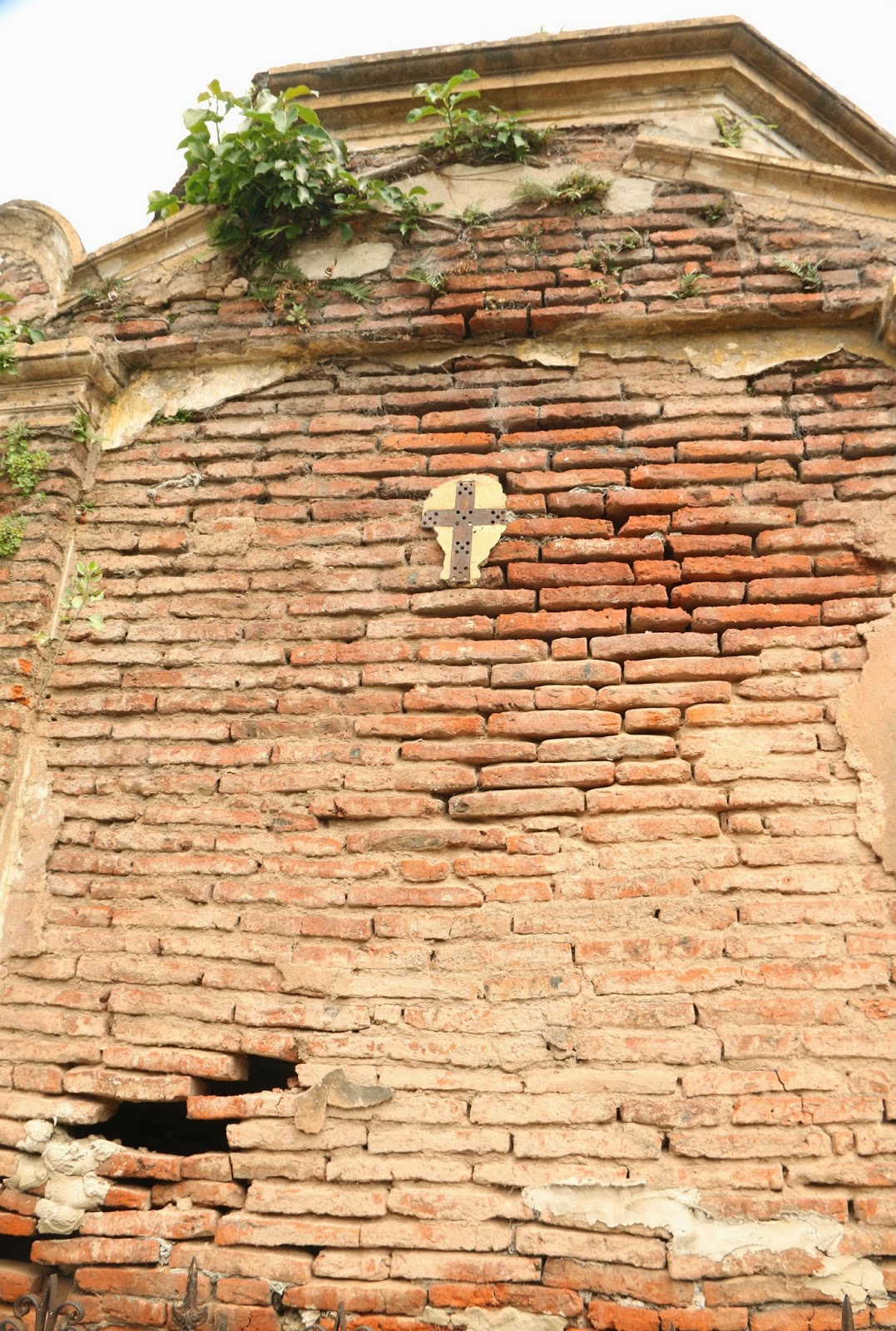On Wednesday, Feb. 25, we did a bus tour,
hop on, hop off. We got off the bus but
it never came back and we waited nearly an hour. That was disappointing. We wandered to another stop and were told
there that the other stop was closed although we had been dropped off
there.
.JPG) |
| My favorite part of this was seeing these geese. |
.JPG) |
| I don't know what they were but they were pretty, and had knots on their heads. |
.JPG) |
| A gaggle was acting like they wanted to join the couple. |
.JPG) |
| This was a large area that we passed, but we weren't sure what it was. At first I thought it was some kind of amusement park, but at second look seemed to be a religious retreat kind of place, maybe. |
.JPG) |
| There's plenty of horseracing here. |
We took the bus to the La Boca
district. The historic neighborhood is
at the mouth of the Riachuelo River and is known for its multi-colored houses,
vibrant street art and a number of atmospheric tango cafes. We chose the worst café in the town, I’m
sure, for our lunch. It was by far the
worst meal we’ve had on this trip.
.JPG) |
| There was painted mural dedicated to fire fighters. |
.JPG) |
| Fire fighters rock!! |
.JPG) |
| The colorful buildings are worth the price of a ride. |
.JPG) |
| The people are proud of their district. |
.JPG) |
| It was a fun place to walk about. |
.JPG) |
| A cruise ship or two had deposited their cruisers. It was a bit crowded. |
.JPG) |
| More places should have so much color. |
The beautiful buildings were so
colorful and fun to see although it was quite crowded with cruise ship
passengers and seemed very touristy.
.JPG) |
| This little entry way was inviting for a photo. |
.JPG) |
| I never miss an opportunity to photograph a horse statue. |
.JPG) |
| Tango anyone? |
.JPG) |
| The use of the corners is intriguing, especially in color. |
.JPG) |
| Every where you look there is color. |
.JPG) |
| There are many tango cafes here and all want you to come watch their show. |
As we were going to catch the bus
to leave, a train whistle was sounding.
I could hear it but didn’t know where it was. I was near train tracks that looked as though
they’d not been used for years. As I
looked down the track, there it came, and people kept crossing. I wasn’t going to, but Jaz hollered the bus
was coming. Others were still crossing
and I wasn’t convinced. Oh hell, I’m
going. Yep, crossed right in front of
that train. My life did not flash before
my eyes.
.JPG) |
| I heard that train a coming, a rolling down that track ... I crossed on over anyway ... and never did look back. |
.JPG) |
| There are many dog walkers in Buenos Aires, walking large numbers of dogs at any time. |
.JPG) |
| Seems like they only walk larger dogs, and have a special harness for attaching them. |
.JPG) |
| Some dog walkers take their charges to the park and tie them out, or let them play. It's quite the operation. |
We got back to the hotel and went
to the bank and on the way back saw a tango show advertised and decided to check it
out. The tango is a sultry dance that
originated in lower-class Buenos Aires during the 1800s. It’s still very popular and is performed with
sensuality and style in tango cafes and ballrooms across the globe. We thoroughly enjoyed it and it was a great
way to end a day that had been quite frustrating.
Thursday, Feb. 26, was the day we
decided to take a taxi to the Harley shop, about 14 miles away. It was quite the trip as our driver wasn’t
100 percent sure where it was. It’s
another district, but he stopped and asked questions and we got there.
.JPG) |
| We were here, Buenos Aires Harley-Davidson. A motorcycle from Brazil was parked there but we didn't see him. |
The Harley shop is not very large and
only has about two types of shirts, T-shirt or polo shirt. What color?
Black or grey. No women’s
shirts. No poker chips. No new bikes.
What?
It turns out they’ve not had bikes or
parts or a lot of things as the government won’t allow them to import from the
U.S. This shop is a dying shop unless
that changes. There’s one more year of the current president and they hope
something may then change. We didn’t
stay long and got another driver to take us back to the Recoleta Cemetery.
This is a famous cemetery, filled with
large statues, and beautiful places for those who are buried here and their
families to visit. Some have benches for sitting and it’s quite exquisite, if
you can use that word for a cemetery.
The entrance to the cemetery is
through gates with tall Greek columns.
The marble mausoleums are elaborate, some are quite exquisite, and most
are decorated with statues that are in a wide variety of styles. The cemetery is laid out in sections like
city blocks with wide walkways branching out into sidewalks with lots of trees. However, we never did figure out how to
determine where we were on the map as we could find no numbers identifying the
blocks.
.JPG) |
| The avenues for the mausoleums are paved with bricks, some of which are loose so you need to watch your footing. |
.JPG) |
| Some look like churches. |
.JPG) |
| Many have stained glass. |
.JPG) |
| Huge statues adorn many. |
.JPG) |
| Little corridors make for some odd-shaped buildings. |
.JPG) |
| But all are unique. |
.JPG) |
| There are shiny brass plaques here and there. |
.JPG) |
| I enjoyed walking down the large walkways. |
.JPG) |
| Here and there is a smaller one tucked in amongst the large ones. |
.JPG) |
| People went all out to honor their passed relatives. |
.JPG) |
| You could sit on the steps and visit. |
.JPG) |
| This was a beautiful one and one of my favorites. |
.JPG) |
| Another needing some repairs. |
.JPG) |
| Some had very different shapes from the norm. |
.JPG) |
| Many had beautiful covers, clean and lacey. All have locks of some sort. |
It’s very expensive to get into this
place, and you can tell by the sights you see.
It’s located in an exclusive Buenos Aires neighborhood and is a virtual
city itself containing about 6,400 architecturally diverse mausoleums including
the black marble crypt of Eva “Evita” Peron.
.JPG) |
| There is a lot of history in just one mausoleum. |
The cemetery has graves of some of the
most influential and important citizens of Argentina, including presidents,
scientists and the wealthy; however, the best known person buried here is Eva
Peron.
Eva
Peron was born May 7, 1919, in Los Toldos, Argentina. She moved to Buenos Aires in the 1930s and
had some success as an actress. She married
Argentine President Juan Peron in 1945 and served as the First Lady of
Argentina from 1946 until she died from uterine cancer in July 1952. Her last public appearance was the month
before her death at her husband’s second inauguration in June 1952. She used her position as first lady to fight
for women’s suffrage and improving the lives of the poor, becoming a legendary
figure in Argentine politics. She was so
revered by the public at the time that she was given a funeral fit for a head
of state.
While many of the mausoleums are much
larger and more beautiful, but the big draw is the aisle where Eva Peron and
her family’s mausoleum is located. There
was a continuous crowd there, and even now, people bring flowers and come to
pay their respects. This woman may be
gone but she is far from forgotten.
.JPG) |
| Large crowds to see the Peron site. |
Some of the mausoleums are in great
shape and well-maintained, looking like new.
Others have fallen into a state of disrepair, which is sad. Each bears a family name, many have brass or
bronze plaques, and most have a death date but not a birth date which is the
tradition for some cemeteries.
.JPG) |
| This is a very old one with very aging bricks needing repair. |
We spent quite a bit of time here as
around every corner was another grave site more fascinating than the previous
one. The original layout was designed by
a French engineer and was remodeled in 1881 by an Italian architect.
.JPG) |
| The large walkways gave a sense of space although there are many packed into a not-so-large area. |
It seemed as though we hadn’t seen
cats anywhere else in the city, but here there were a number of them. It turns out there are about 80 cats at the
Recoleta Cemetery. They seem to act as
tour guides and are watchful guardians to the tombs of the people that are a
part of the 5.4-acre cemetery.
.JPG) |
| You know these are from the same grou |
The cats have been a part of the
cemetery history for more than 20 years.
They’re spayed or neutered and fed twice daily; some have even been
adopted over the years by visitors. A
colony of cats is a group that band together and share an area. There are various colonies throughout the
cemetery. Some are very friendly, while
others are timid and not so friendly.
Some have been dumped or abandoned on the cemetery grounds and lost or
strays have found their way to the safe haven, as well. The expense of feeding the cats is about
eight pounds of kibble a day, including supplements. The colony caretaker has absorbed the entire
cost for their care.
After we opted for lunch where there was a concertina player. The food was great, too.
.JPG) |
| We stopped for a moment on our walk back to the hotel and were privileged to see a flag-lowering ceremony. That was pretty cool and a total fluke to happen on it. |
We opted for lunch where there was a concertina player. The food was great, too.
.JPG) |
Too bad he quit playing just after we got there.
|
.JPG) |
| As our walk continued we saw the produce truck dropping off fruits and vegetables at a market. |
.JPG) |
And we found out how pizza gets delivered, via motor scooters.
What a great day. But we will soon be leaving Buenos Aires to start the next leg of our adventure.
|
.JPG)
.JPG)
.JPG)
.JPG)
.JPG)
.JPG)
.JPG)
.JPG)
.JPG)
.JPG)
.JPG)
.JPG)
.JPG)
.JPG)
.JPG)
.JPG)
.JPG)
.JPG)
.JPG)
.JPG)
.JPG)
.JPG)
.JPG)
.JPG)
.JPG)
.JPG)
.JPG)
.JPG)
.JPG)
.JPG)
.JPG)
.JPG)
.JPG)
.JPG)
.JPG)
.JPG)
.JPG)
.JPG)
.JPG)
.JPG)
.JPG)
.JPG)
.JPG)
.JPG)
.JPG)
.JPG)
.JPG)
.JPG)
.JPG)
.JPG)
.JPG)
.JPG)
No comments:
Post a Comment